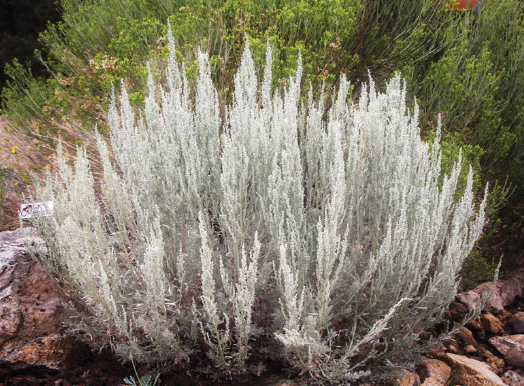
Plant Form: Evergreen shrub
Water Use: Low
Mature Size: 3-6 (-15) ft. tall x 3-10 ft. wide
Exposure: Full sun
Bloom Time: Summer (July-Aug), Fall (Sept)
Hardiness: Cold Hardy to -20°F
Native to: Canada, Western North America, Baja California
Great Basin Sage is a study in silver and gray. This shrub forms the primary vegetation across vast stretches of the Great Basin desert. A member of the sunflower family, it develops a woody trunk that twists in age and becomes picturesque, reminiscent of a bonsai specimen. Spikes of tiny, pale yellow flowers are inconspicuous. Silvery, felt-like hairs cover the wedge-shaped leaves that have 3 to 5 teeth at their tip. The foliage is extremely aromatic, and is used to make smudge bundles for cleansing and purifying. In fact, this sagebrush’s pungent fragrance, especially after a desert rainstorm, is one of the high desert’s signature aromas. Prune out old stems periodically to encourage attractive new growth. Its silver foliage adds texture and light to the landscape, and sets off nearby dark green plants. This plant is valuable to wildlife and butterflies, and is useful on banks and slopes, or as an informal hedge, groundcover, or screen.
THIS MONTH IN YOUR DESERT-SMART LANDSCAPE
Smart water-wise practices pay off now: climate-adapted plants+ mulch+ deep watering=less water use.
- Check irrigation emitters, valves, and lines for clogs, leaks, and breaks.
- Flush out lines by removing end caps with your water system on; sand or deposit that build up in lines can clog emitters.
- Leave a dripping hose at the drip-line of trees and shrubs to deeply soak soil once a month; set a timer to remind you to move hose to next plant.
- Keep adding to mulches as they decompose to conserve water, keep roots cool, and reduce frequency of watering.
- Encourage repeat blooming by pinching or cutting back annuals, perennials, and shrubs.